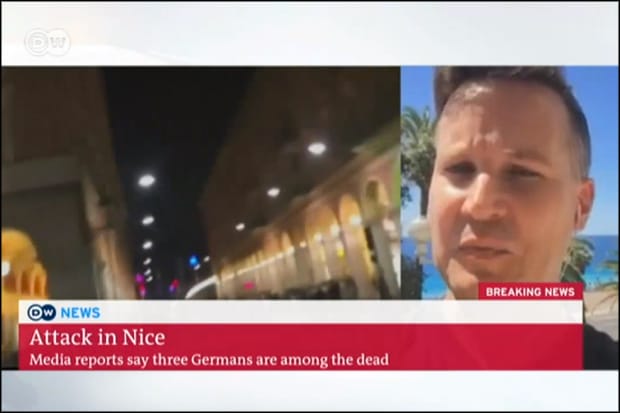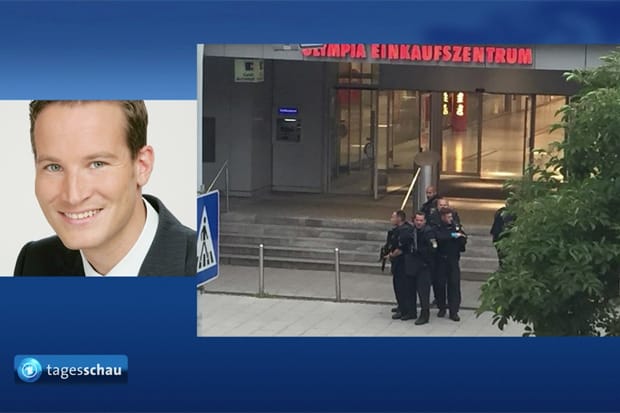How one reporter covered the attacks in Nice and Munich with a mobile phone
Richard Gutjahr, reporter for German national broadcaster ARD, explained how basic mobile technology allowed him to cover the two attacks


Richard Gutjahr, reporter for German national broadcaster ARD, explained how basic mobile technology allowed him to cover the two attacks
This article was migrated from an old version of our website in 2025. As a result, it might have some low-quality images or non-functioning links - if there's any issues you'd like to see fixed, get in touch with us at info@journalism.co.uk.
Using just his mobile phone, Richard Gutjahr, reporter for German national broadcaster ARD, has produced on-the-scene coverage of two attacks in the past two weeks: the Bastille Day lorry killings in Nice (14 July), and Friday's fatal shootings in Munich shopping centre Olympia Einkaufszentrum (22 July).
Gutjahr lives in Munich and went on vacation to France specifically for Bastille Day. On both occasions, he was caught off-guard, without his usual bag of mobile journalism (mojo) equipment that includes a tripod, selfie stick, lenses and bluetooth microphones, but was able to cover the attacks with just the iPhone in his pocket.
"I didn't use fancy mojo reporting tools at all – I just used the best equipment that I had in the given situations, which was my mobile phone."
While on holiday in Nice for the Bastille Day celebrations, Gutjahr spontaneously reported from the scene of the lorry attack, with pre-recorded footage and over 80 live interviews for news broadcasters worldwide.
"People were calling me like crazy – I was using Skype to broadcast live for a total of 24 hours without any breaks, working straight through until 10pm the following night," he said.
Having initially wanted to produce a Snapchat story of the festivities, Gutjahr was stood on his hotel balcony filming the fireworks at 10:35pm when he noticed people running and screaming in the street below him.
Everyone was expecting me to livestream but the best reporting I did that night was the reporting I did not do - Richard Gutjahr, ARD
"I saw something was wrong – something just didn't fit the image," he said.
"I happened to have my camera in my hand because I was still Snapchatting the fireworks, so not knowing what to expect, I turned the camera from vertical view to the horizontal position and used the phone's regular camera to film. I didn't want this to be on Snapchat."
The truck driver had started his attack roughly 2 kilometres down the road, so Gutjahr did not have any immediate knowledge of what had happened, but carried on filming – ducking for his safety when gunshots were fired – until the truck had gone past him.
Once the gunfire had stopped and the truck was stationary, Gutjahr ran out on to the street with his iPhone to record footage of what was happening, seeing the dead on the ground and wounded people being brought into the nearby hotels.
"I took some footage from across the street to capture the scenes after the truck had been stopped, but it was deliberately shot so you couldn't see any details, while being aware there were bodies on the street," he said.
Gutjahr tweeted about the event with a non-graphic picture, before going back to his hotel and informing colleagues at ARD that there had been a possible terror attack and that he had footage.
Gutjahr, who also holds workshops on livestreaming, decided not to Periscope the aftermath, but rather let ARD decide what footage should be broadcast to the public.
"I decided against Snapchat, YouTube, Facebook Live or Periscope, because I had the feeling that this would not be wise in this situation, where anything could happen. I was also shocked and would not have been in the right state of mind to decide what to show and what not to," he said.
"I needed someone with a distant and objective view on the imagery to decide what was newsworthy."
Tweet content
— User View on Twitter
"Everyone was expecting me to livestream, but the best reporting I did that night was the reporting I did not do."
Gutjahr Skyped live from his balcony, which overlooked ambulances, police lights and helicopters at the scene. He was careful to ensure there were no wounded people in the frame.
"If there were people in the background then I would have just turned my smartphone to the other direction," he said.
"It was night, and I was broadcasting using Skype on a mobile phone, so all these factors assured that no matter where I pointed my camera, it was clearly too far away to show something bad."
"I usually take my equipment everywhere I go with me, so I have it at my disposal," said Gutjahr.
"But this was the first time I didn't have it with me – all I had was my iPhone and my Apple headphones, which thankfully had a mic on."
Gutjahr also had an external battery pack, which lasted him through the international livestreaming he signed up to do.
"I was able to report from the balcony without being attached to a plug," he said.
"I used the external battery in order to charge my phone while I was talking into it, and once the battery died on the external battery, I charged it for 2 hours in my room before charging my dying iPhone again with it – that happened six or seven times."

Gutjahr noted that even with his limited resources, he was able to take good quality pictures and HD video, and deliver approximately 80 live broadcasts to TV and radio stations.
"We know those smartphone cameras are bad without sufficient light, but I still took good photographs, pretty decent HD video and could still Skype on 3G network well, so to my surprise it turned out to be good enough to report with," he said.
"But I certainly was missing the rest of my equipment, especially my selfie stick and tripod. My arm was shaky as I had to hold my arm up far away from me – I can still feel it now."
He told ARD to give the footage to the European Broadcasting Union, so that more publishers would have access to it for free.
"It was really hard for people to watch the Snapchat story the next day when they knew what was about to happen – people told me they cried when they had seen it," he said.
Gutjahr was on his way to work at ARD when a friend informed him there had been shootings in Munich shopping centre Olympia Einkaufszentrum.
"When I got the text message, I was 5 minutes away from the shopping mall, so it triggered my reporter instinct to go there to see if it was something bigger or a minor incident," he said.
After hearing the sirens of more than 20 police cars, he went and parked outside the shopping centre just in time before police had blocked the road.
Using just his phone, Gutjahr was able to report live from the scene just 10 minutes later on the Bavarian branch of ARD's evening news bulletin.
"There was no time to test video or Skype, so they told me to stay on the line – we went on air right away," he said.
"It was good, old reporting like back in the 50s, where I was just on a phone call telling them what I observed from outside the building, that there was a helicopter, police in heavy gear blocking the road, and that I had hearsay of a shooting from one private source but no further information."
Gutjahr broadcast in this way at regular intervals throughout the evening, on the news programmes of ARD and its associated broadcasting stations, moving from the scene of the attack to an apartment housing witnesses, and then to an impromptu press conference.
After Gutjahr produced some phone reports, ARD sent a camera crew to the shopping mall for further coverage. However, technical difficulties meant his colleague’s live stream wasn't working, so Gutjahr had to step in, live on air.
"Our primetime news at 8pm is the most-watched television news show in Germany, watched by eight to ten million people," said Gutjahr.
"The satellite link to him was failing live on air, in that one could see him but not hear him. Luckily they had me as a back-up on the phone for emergencies so I was able to give a report."

Criticism by the public over tweeting pictures of the scene
He chose not to livestream from the scene, but took photos and videos which he sent to ARD to use in their news bulletins.
He was criticised for tweeting three photos from the scene by people who believed he was telling the shooters where the police were located, although he waited 30 minutes to post the images.
"I do understand that it is sensitive ground and you should be careful with that, but that night there were at least a dozen rumours in several parts of the city where people said they heard gunshots, there was actual panic and running, but it wasn't true, so I felt that I was obligated to do something more to say 'I am here'," he said.
"I wanted people to be able to ask me questions, and didn't think that showing a picture of policemen, whose faces you couldn't identify, would be critical."
He later decided to delete the tweet with the images, which were later used by ARD and national newspapers, as a symbolic gesture, aware of his responsibility as a role model to younger journalists, aiming to show that one shouldn't just tweet and post about events just because the option is there.
"It is a catch-22 situation that every reporter will find himself in," he said.
"You need to do your job, and with all the criticism out there – for which I have great sympathy for – I am a reporter, and a reporter needs to show and give reference to what they are doing."